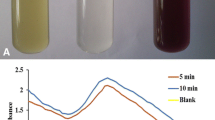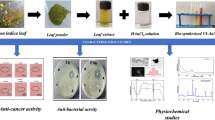Abstract
The Romanian propolis was extracted in five different media, respectively, in water (pH 6.8), glycine buffer (pH 2.5), acetate buffer (pH 5), phosphate buffer (pH 7.4) and carbonate buffer (pH 9.2). The extracts presented different amounts of flavonoids and phenolic acids, increasing pH leading to higher concentrations of active compounds. Five variants of gold nanoparticles suspensions based on different pH Romanian propolis aqueous extracts were successfully synthesized. The obtained nanoparticles presented dimensions between 20 and 60 nm in dispersion form and around 18 nm in dried form, and different morphologies (spherical, hexagonal, triangular). Fourier transform infrared spectroscopy proved the attachment of organic compounds from propolis extracts to the colloidal gold suspensions and X-ray diffraction certified that the suspensions contain metallic gold. The obtained propolis gold nanoparticles do not exhibit any antibacterial or antifungal activity, but presented different catalytic activities and toxicity on tumour cells.







Similar content being viewed by others
References
Ahmad A, Senapati S, Khan MI, Kumar R, Sastry M (2003a) Extracellular biosynthesis of monodisperse gold nanoparticles by a novel extremophilic actinomycete, Thermomonospora sp. Langmuir 19:3550–3553
Ahmad A, Mukherjee P, Senapati S, Mandal D, Khan MI, Kumar Sastry RM (2003b) Extracellular biosynthesis of silver nanoparticles using the fungus Fusarium oxysporum. Coll Surf B 28:313–318
Ahmed KBA, Subramanian S, Sivasubramanian A, Veerappan G, Veerappan A (2014) Preparation of gold nanoparticles using Salicornia brachiata plant extract and evaluation of catalytic and antibacterial activity. Spectrochim Acta A 130:54–58
Aromal SA, Philip D (2012) Green synthesis of gold nanoparticles using Trigonella foenum-graecum and its size-dependent catalytic activity. Spectrochim Acta A 97:1–5
Bankova V (2005) Recent trends and important developments in propolis research. eCAM 2:29-32
Basavegowda N, Idhayadhulla A, Lee YR (2014) Phyto-synthesis of gold nanoparticles using fruit extract of Hovenia dulcis and their biological activities. Ind Crops Prod 52:745–751
Begum NA, Mondal S, Basu S, Laskar RA, Mandal D (2009) Biogenic synthesis of Au and Ag nanoparticles using aqueous solutions of black tea leaf extracts. Coll Surf B 71:113–118
Bhattacharya R, Mukherjee P (2008) Biological properties of “naked” metal nanoparticles. Adv Drug Deliv Rev 60:1289–1306
Boisselier E, Astruc D (2009) Gold nanoparticles in nanomedicine: preparations, imaging, diagnostics, therapies and toxicity. Chem Soc Rev 38:1759–1782
Brambilla L, Riedo C, Baraldi C, Nevin A, Gamberini MC, D’Andrea C, Chiantore O, Goidanich S, Toniolo L (2011) Characterization of fresh and aged natural ingredients used in historical ointments by molecular spectroscopic techniques: IR, Raman and fluorescence. Anal Bioanal Chem 401:1827–1837
Chen X, Schluesener HJ (2008) Nanosilver: a nanoproduct in medical application. Toxicol Lett 176:1–12
Connor EE, Mwamuka J, Gole A, Murphy CJ, Wyatt MD (2005) Gold nanoparticles are taken up by human cells but do not cause acute cytotoxicity. Small 1:325–327
De Groot AC, Popova MP, Bankova VS (2014) An update on the constituents of poplar-type propolis. Acdegroot publishing, Wapserveen. ISBN/EAN: 978-90-813233-0-7
Dhas TS, Kumar VG, Abraham LS, Karthick V, Govindaraju K (2012) Sargassum myriocystum mediated biosynthesis of gold nanoparticles. Spectrochim Acta A 99:97–101
Dhas TS, Kumar VG, Karthick K, Govindaraju K, Narayana TS (2014) Biosynthesis of gold nanoparticles using Sargassum swartzii and its cytotoxicity effect on HeLa cells. Spectrochim Acta A 133:102–106
Dimitrijevic NM, Bartels DM, Jonah CD, Takahashi K, Rajh T (2001) Radiolytically induced formation and optical absorption spectra of colloidal silver nanoparticles in supercritical ethane. J Phys Chem B 105:954–959
Dubey SP, Lahtinen M, Sillanpää M (2010) Tansy fruit mediated greener synthesis of silver and gold nanoparticles. Process Biochem 45:1065–1071
Gatea F, Teodor ED, Matei AO, Badea GI, Radu GL (2015) Capillary electrophoresis method validation for 20 polyphenols separation in propolis and plant extracts. Food Anal Methods 8:1197–1206
Giljohann DA, Seferos DS, Daniel WL, Massich MD, Patel PC, Mirkin CA (2010) Gold nanoparticles for biology and medicine. Angew Chem Int Ed Engl 49:3280–3294
Hervés P, Pérez-Lorenzo M, Liz-Marzán LM, Dzubiella J, Lu Y, Ballauff M (2012) Catalysis by metallic nanoparticles in aqueous solution model reactions. Chem Soc Rev 41:5577–5587
Hu R, Yong K-T, Roy I, Ding H, He S, Prasad PN (2009) Metallic nanostructures as localized plasmon resonances enhanced scattering probes for multiples dark field targeted imaging of cancer cells. J Phys Chem C 113:2676–2684
Kumar VG, Gokavarapu SD, Rajeswari A, Dhas TS, Karthick V, Kapadia Z, Shrestha T, Barathy IA, Roy N, Sinha S (2011) Facile green synthesis of gold nanoparticles using leaf extract of antidiabetic potent Cassia auriculata. Coll Surf B 87:159–163
Kurek-Górecka A, Rzepecka-Stojko A, Górecki M, Stojko J, Sosada M, Świerczek-Zięba G (2014) Structure and antioxidant activity of polyphenols derived from propolis. Molecules 19:78–101
Lazar V, Balotescu C, Cernat R, Bulai D, Nitu G, Ilina L (2003) Phenotypic antibiotic resistance of some enterobacterial strains adhered to an inert substratum. In vitro models for biofilm formation in liquid and solid media. Clin Microbiol Infect 9(Suppl. 1):227–232
Lee JS, Jang J (2014) Hetero-structured semiconductor nanomaterials for photocatalytic applications. J Ind Eng Chem 20:363–371
Lee KY, Hwang J, Lee YW, Kim J, Han SW (2007) One-step synthesis of gold nanoparticles using azacryptand and their applications in SERS and catalysis. J Coll Interf Sci 316:476–481
Lokina S, Suresh R, Giribabu K, Stephen A, Sundaram RL, Narayanan V (2014) Spectroscopic investigations, antimicrobial, and cytotoxic activity of green synthesized gold nanoparticles. Spectrochim Acta A 129:484–490
Mondal S, Roy N, Laskar RA, Ismail SK, Basu S, Mandal D, Begum NA (2011) Biogenic synthesis of Ag, Au and bimetallic Au/Ag alloy nanoparticles using aqueous extract of mahogany (Swietenia mahogani JACQ) leaves. Coll Surf B 82:497–504
Mossmann T (1983) Rapid colorimetric assay for cellular growth and survival: application to proliferation and cytotoxicity assays. J Immunol Methods 65:55–63
Mukherjee P, Ahmad A, Mandal D, Senapati S, Sainkar SR, Khan MI, Ramani R, Pasricha R, Ajaykumar PV, Alam M, Sastry M, Kumar R (2001) Bioreduction of AuCl4 ions by the fungus, Verticillium sp. and surface trapping of the gold nanoparticles formed. Angew Chem Int Ed Eng 40:3585–3588
Mulvaney P (1996) Surface plasmon spectroscopy of nanosized metal particles. Langmuir 12:788–800
Narayanan KB, Sakthivel N (2011) Extracellular synthesis of silver nanoparticles using the leaf extract of Coleus amboinicus Lour. Mater Res Bull 46:1708–1713
Noruzi M, Zare D, Khoshnevisan K, Davoodi D (2011) Rapid green synthesis of gold nanoparticles using Rosa Hybrida petal extract at room temperature. Spectrochim Acta A 79:1461–1465
Rajathi FAA, Parthiban C, Kumar VG, Anantharaman P (2012) Biosynthesis of antibacterial gold nanoparticles using brown alga, Stoechospermum marginatum (Kützing). Spectrochim Acta A 99:166–173
Roy N, Mondal S, Laskar SA, Basu S, Mandal D, Begum NA (2010) Biogenic synthesis of Au and Ag nanoparticles by Indian propolis. Coll Surf B 76:317–325
Shankar SS, Ahmad A, Pasricha R, Sastry M (2003) Bioreduction of chloroaurate ions by geranium leaves and its endophytic fungus yields gold nanoparticles of different shapes. J Mater Chem 13:1822–1826
Shankar SS, Rai A, Ahmad A, Sastry M (2004) Rapid synthesis of Au, Ag and bimetallic Au-core Ag-shell nanoparticles using Neem (Azadirachta indica) leaf broth. J Coll Interf Sci 275:496–502
Shankar SS, Rai A, Ahmad A, Sastry M (2005) Controlling the optical properties of lemongrass extract synthesized gold nanotriangles and potential application. Chem Mater 17:566–572
Socrates G (2001) Infrared and Raman characteristic group frequencies: tables and charts, 3rd edn. Wiley, Chichester
Sperling RA, Gil PR, Zhang F, Zanella M, Parak WJ (2008) Biological applications of gold nanoparticles. Chem Soc Rev 37:1896–1908
Suman TY, Rhadika Rajasree SR, Ramkumar R, Rajthilak C, Perumal P (2014) The green synthesis of gold nanoparticles using an aqueous root extract of Morinda citrifolia L. Spectrochim Acta A 118:11–16
Venkatachalam M, Govindaraju K, Sadiq AM, Tamilselvan S, Kumar VG, Singaravelu G (2013) Functionalization of gold nanoparticles as antidiabetic nanomaterial. Spectrochim Acta A 116:331–338
Yin B, Ma H, Wang S, Chen S (2003) Electrochemical synthesis of silver nanoparticles under protection of poly (N-vinylpyrrolidone). J Phys Chem B 107:8898–8904
Yue H-L, Hu Y-J, Huang H-G, Jiang S, Tu B (2014) Development of morin-conjugated Au nanoparticles: exploring the interaction efficiency with BSA using spectroscopic methods. Spectrochim Acta A 130:402–410
Zhou X, Xu W, Liu G, Panda D, Chen P (2010) Size-dependent catalytic activity and dynamics of gold nanoparticles at the single-molecule level. J Am Chem Soc 132:138–146
Acknowledgments
This work was supported by NUCLEU-BIODIV-PN 09-360101/2009 under the authority of Romanian Agency for Scientific Research. The authors are grateful to Dr. Gabriela Negroiu from the Institute of Biochemistry of Romanian Academy, who kindly provided us the MEL-JUSO cell line.
Funding
All the funds are provided by Romanian Agency for Scientific Research.
Author information
Authors and Affiliations
Corresponding author
Ethics declarations
Conflict of interest
All the authors declare that they have no conflict of interest.
Human and animal rights and informed consent
This article does not contain any studies with human or animal subjects.
Rights and permissions
About this article
Cite this article
Gatea, F., Teodor, E.D., Seciu, AM. et al. Antitumour, antimicrobial and catalytic activity of gold nanoparticles synthesized by different pH propolis extracts. J Nanopart Res 17, 320 (2015). https://doi.org/10.1007/s11051-015-3127-x
Received:
Accepted:
Published:
DOI: https://doi.org/10.1007/s11051-015-3127-x




